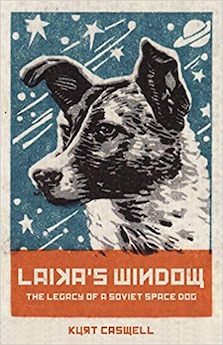By Jay M. Pasachoff
As we approach the 50th anniversary of the first crewed Moon landing on July 20, 2019, there are many ways we can consider the impact of that epochal event. Many of them are, interestingly but unusually, considered in the book by Kurt Caswell, thoroughly and ostensibly about the first animal sent into orbit but also about the ramifications of the space program in the United States and around the world. Caswell, a professor of creative writing and literature in the Honors College at Texas Tech (and, somehow, Vermont College of Fine Arts), has written a wide-ranging book with the famous Laika at the center.
Without Laika’s mission, on Sputnik II launched on November 3, 1957, the human spaceflight that followed would not have taken place, the author explains. It had not been clear that life could survive in space—and I learned even that humans are launched on their backs so that their lungs could expand upward during the high-g forces of launch. Caswell has done his homework, tracking down with difficulty how long Laika survived—not as long as the Soviet Union tried and succeeded to imply.
Another point that Caswell discovered in his research was that Laika indeed had a view out the small window that had been put into the capsule, though the capsule was spinning at some slow rate as a result of its launch-spin for stabilization. So she had an early view of the Earth from space that, once viewed and photographed by humans, led to our current ecological movement.
We Americans seem to be moving back into the space-launch business, with Elon Musk’s recent robotic Dragon capsule launched with a SpaceX Falcon 9 linking with the International Space Station as a test. It even had a plush Earth toy, a Celestial Buddy, on board as a sensor (Musk tweeted) of when “weightless” began (correctly explained by the author as joint free fall rather than an actual loss of weight).
Laika—apparently the second choice of the Soviets to send into space because their favorite had recently become a mother—was the first of a series of Soviet space dogs, the improbable subject of an exhibition of oil paintings of Soviet Space dogs I had seen at the quirky but fascinating Museum of Jurassic Technology in Culver City, California (a bit south of Beverly Hills). “Until Laika’s flight, scientists did not know what would happen to a living organism outside the protection of Earth’s atmosphere where there is no oxygen to breathe, weakened gravity, and increased radiation…. How long, scientists wanted to know, could a living organism survive in orbit? Five minutes? Three days? One year? No one knew.”
Did I myself see Laika’s capsule (or at least the rocket’s final stage) in space, when as a Bronx High School of Science student I was on top of New York’s RCA building at dawn as part of the Moonwatch Patrol to pin down the path of the earliest satellites across the sky? It’s likely. One of the original Moonwatch telescopes is in the collection of Harvard’s Collection of Historic Scientific Instruments, and I participated last year in a filming of it for Smithsonian TV.
Caswell discusses a number of philosophical aspects of Laika’s launch. Laika was slated to die in orbit, and should such a creature be sent for such a task? (The Americans later used chimpanzees, not dogs.) What did the Soviet’s launch of Sputniks imply about their ability to lob a nuclear bomb into the United States? “Khrushchev taunted the U.S., calling Vanguard I a grapefruit.”
When four years later the Soviet Union put Yuri Gagarin into orbit, and he was able to look out the window at Earth as Laika had previously (though it took Caswell some substantial sleuthing to verify that), Caswell reports that “Gagarin later wrote. ‘People, let us preserve and increase this beauty, not destroy it.’” I had not expected Sylvia Plath to be cited, but her view of loneliness, and Caswell’s consideration of astronauts’ feelings of loneliness in space (cited from at least two interviews of astronauts he carried out) appeared.
What to think of today’s presidential budget request to cut back on NASA’s funds for going to Mars and expanding them for going to the Moon? Caswell explains how his view on space travel to Mars has changed from negative to positive. “It’s clear that our government is failing, at least in the short term, to unite us as a people. But perhaps Mars can do it…. Perhaps Mars can unite the U.S. with the rest of the world….”
As the author summarizes, “When the people of Earth gaze up at that small red point in the morning sky that is Mars, and the first Mars colonists stand with their dogs looking back at the beauty of the Earth, it will be with gratitude to Laika, who showed us all the way.”
Astronomer and author Jay M. Pasachoff is the director of the Hopkins Observatory and Field Memorial Professor of Astronomy at Williams College. He is a Visitor at the Carnegie Observatories. Williams College is home to the Gamma of Massachusetts Chapter of Phi Beta Kappa.




